


Robinson art in #2 |
And he's in #2 of |
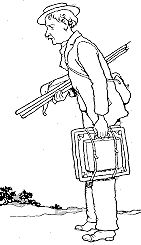
 William Heath
Robinson was the younger brother of Charles
and Thomas Heath Robinson. Like Charles, he was equally at home
with line and watercolor, but he brought a unique humor to his
art mostly absent from that of his brothers.
William Heath
Robinson was the younger brother of Charles
and Thomas Heath Robinson. Like Charles, he was equally at home
with line and watercolor, but he brought a unique humor to his
art mostly absent from that of his brothers.
He was born in 1872 to the same generation of his brothers (Thomas was 1869, Charles was 1870), Eric Pape, Maxfield Parrish, Orson Lowell, Franklin Booth, Elizabeth Shippen Green, and J.C. Leyendecker. Rackham was five years his senior and Dulac ten years his junior.
The Robinsons' father, uncle and grandfather were all employed
either drawing or engraving images for publication. As Robinson
grew up, so did the new methods of "process" - or the
photographic transfer of an artist's drawing to an engraved printing
plate. (See my Daniel Vierge
page for more details on the impact of this technique.)
 Geoffrey
Beare, in one of his many wonderful essays on the Robinsons, points
out that the 1890's were an explosive period of growth for printed
media. The new process techniques eliminated the costly and time-consuming
interpretation of the engraver. Beare points out, "...there
was only one process-engraving firm in London in 1876, by 1900
there were fifty-six producing about a thousand blocks a week
for periodicals alone."
Geoffrey
Beare, in one of his many wonderful essays on the Robinsons, points
out that the 1890's were an explosive period of growth for printed
media. The new process techniques eliminated the costly and time-consuming
interpretation of the engraver. Beare points out, "...there
was only one process-engraving firm in London in 1876, by 1900
there were fifty-six producing about a thousand blocks a week
for periodicals alone."
Heath Robinson, having studied art at the Islington School of Art and sporadically at the Painting Schools of the Royal Academy, truly wished to make a living as a landscape painter. At the age of 25, however, came the rude realization that making drawings for the burgeoning publications of the day was likely to earn him a living, whereas the sale of just one landscape that year (to a friend) was not. His brothers had already started their illustration careers, and it seemed it was time for young Will to join them. That year, 1897, he produced illustrations for four books:
- The Giant Crab and Other Tales From Old India
- Danish Fairy Tales and Legends of Hans Andersen
- Don Quixote
- The Pilgrim's Progress
 These
early efforts were in search of a style. The seated couple above
left is from the 1898 The Queen's Story Book. Other images
were strikingly different, similar to Astarte from
his 1900 The Poems of Edgar Allen Poe. It's interesting
to note both the lingering influence of wood-engraving in his
early work and his tendency towards more serious subjects. Cervantes
(he'd tackle Quixote again in 1902 and yet again
in 1953), John Bunyan, and Poe were not the typical fairy tale
romantic stuff that brother Charles and many others were doing
contemporaneously.
These
early efforts were in search of a style. The seated couple above
left is from the 1898 The Queen's Story Book. Other images
were strikingly different, similar to Astarte from
his 1900 The Poems of Edgar Allen Poe. It's interesting
to note both the lingering influence of wood-engraving in his
early work and his tendency towards more serious subjects. Cervantes
(he'd tackle Quixote again in 1902 and yet again
in 1953), John Bunyan, and Poe were not the typical fairy tale
romantic stuff that brother Charles and many others were doing
contemporaneously.
 So
it came as some surprise that in 1902 he wrote and drew an appealing
and fanciful children's book, The Adventures of Uncle Lubin
(see left). And even more surprising that he would contract with
the same publisher to next illustrate Rabelais.
So
it came as some surprise that in 1902 he wrote and drew an appealing
and fanciful children's book, The Adventures of Uncle Lubin
(see left). And even more surprising that he would contract with
the same publisher to next illustrate Rabelais.
Rabelais, published in 1904 had over 250 WHR b&w illustrations, with a flowing line that owed more to Art Nouveau than to any historic vestige of wood-engraving. This two-volume set was well received. There was even an edition of 25 deluxe copies, preceding by a year the generally acknowledged birth of the Gift Book in 1905. The book changed Robinson's life and career, but not quite in the way one would have expected. You see, the publisher went bankrupt before WHR got paid.
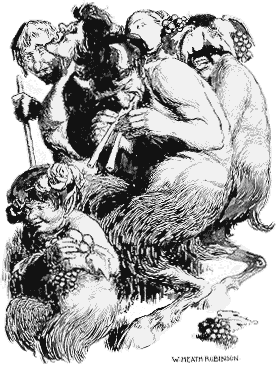 With
drawings like the one at left establishing him as a major artist,
Robinson was suddenly prestige rich and pound poor. The most accessible
source of immediate income came not from another book publisher,
but from the weekly magazines like The Tattler, The
Bystander and The Sketch. He got to work and produced
b&w humorous drawings for them, and displayed the detached
serious silliness for which he became famous. He produced several
sets of eight small paintings for a 'Told to the Little Folks'
series of books for T.C. and E.C. Jack. The books, Chaucer,
The Iliad, and The Odyssey in 1905 and 1906, were
quick, and quickly printed income. These were among his first
color (or should I say 'colour'?) commissions (he did 12 plates
for The Child's Arabian Nights in 1903). Two volumes of
The Monarchs of Merry England in 1907 and 1908 featured
"Humorous Rhymes of Historical Types" and twenty color
plates. They suffered, however, from having the color plates printed
on the same porous paper as the text - giving them a washed-out
appearance.
With
drawings like the one at left establishing him as a major artist,
Robinson was suddenly prestige rich and pound poor. The most accessible
source of immediate income came not from another book publisher,
but from the weekly magazines like The Tattler, The
Bystander and The Sketch. He got to work and produced
b&w humorous drawings for them, and displayed the detached
serious silliness for which he became famous. He produced several
sets of eight small paintings for a 'Told to the Little Folks'
series of books for T.C. and E.C. Jack. The books, Chaucer,
The Iliad, and The Odyssey in 1905 and 1906, were
quick, and quickly printed income. These were among his first
color (or should I say 'colour'?) commissions (he did 12 plates
for The Child's Arabian Nights in 1903). Two volumes of
The Monarchs of Merry England in 1907 and 1908 featured
"Humorous Rhymes of Historical Types" and twenty color
plates. They suffered, however, from having the color plates printed
on the same porous paper as the text - giving them a washed-out
appearance.
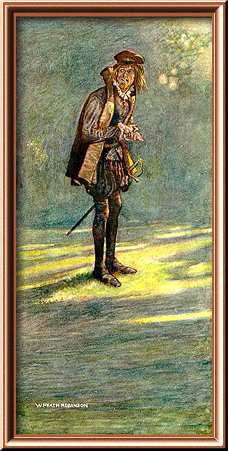 As
WHR reconstructed his life and career, the entire gift book industry
had taken the populace and publishers by storm. It is generally
acknowledged to have had its roots in Heinemann's 1905 Rip
Van Winkle with 51 color plates by Arthur Rackham. The printing of the images
on coated paper which were then tipped onto pages bound into the
book allowed the printers to achieve a brilliant image that reproduced
the artists' work more faithfully than ever before. Robinson's
first entry into this teeming market was his 1908 Twelfth Night
or What You Will. True to his serious side (and to his early
intent to paint landscapes...), he chose a Shakespeare play with
few opportunities for fantasy. (The same year Rackham did an edition
of A Midsummer Night's Dream.) 40 tipped-in color plates
were as much studies in light and shadow (see sample at right)
as they were illustrations for the play - the settings quite often
overpower, and literally overshadow, the players.
As
WHR reconstructed his life and career, the entire gift book industry
had taken the populace and publishers by storm. It is generally
acknowledged to have had its roots in Heinemann's 1905 Rip
Van Winkle with 51 color plates by Arthur Rackham. The printing of the images
on coated paper which were then tipped onto pages bound into the
book allowed the printers to achieve a brilliant image that reproduced
the artists' work more faithfully than ever before. Robinson's
first entry into this teeming market was his 1908 Twelfth Night
or What You Will. True to his serious side (and to his early
intent to paint landscapes...), he chose a Shakespeare play with
few opportunities for fantasy. (The same year Rackham did an edition
of A Midsummer Night's Dream.) 40 tipped-in color plates
were as much studies in light and shadow (see sample at right)
as they were illustrations for the play - the settings quite often
overpower, and literally overshadow, the players.
 His
next color-plate books would continue this maverick strain. Those
were A Song of the English and The Collected Verse of
Rudyard Kipling in 1909 and 1910, respectively. Take a look
at the image at left (from Collected Verse) and think of
Edmund Dulac's The Sleeping
Beauty and Other Fairy Tales or Rackham's
Undine, both from the same year. Similar production values
but a markedly different choice of both book and subject for images.
His
next color-plate books would continue this maverick strain. Those
were A Song of the English and The Collected Verse of
Rudyard Kipling in 1909 and 1910, respectively. Take a look
at the image at left (from Collected Verse) and think of
Edmund Dulac's The Sleeping
Beauty and Other Fairy Tales or Rackham's
Undine, both from the same year. Similar production values
but a markedly different choice of both book and subject for images.
Robinson was capable of fancy, but fantasy itself seems to have been a stretch for him. Even his humor is rooted firmly in the real world and derives much of it's success from taking fanciful situations and grounding them firmly in a world that still followed the laws of physics. This tendency makes the books he wrote all the more startling and successful.

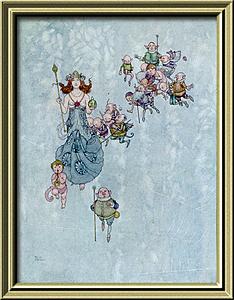 The
image above, from his 1912 classic, Bill the Minder, initially
appears to be of a boy levitating contrary to those physical laws,
but he turns out to be falling from a tree above the tea table.
I don't want to imply that he was incapable of rendering fantasy
for he did a goodly complement of fairies for his 1912 A Mid-Summer
Night's Dream. But even there, if you examine one of the more
fantastic images in the book, at right, you notice a few traits:
1. the composition distances the viewer (and the creator?) from
the fairies. 2. rather than airy weightlessness, these imaginary
folk seem fully aware of the laws of gravity, and 3. if you look
closely enough you'll see that instead of floating or flying through
the air, they are walking across a spider web. It's as if Robinson
wanted even his fairies grounded in a semblance of reality.
The
image above, from his 1912 classic, Bill the Minder, initially
appears to be of a boy levitating contrary to those physical laws,
but he turns out to be falling from a tree above the tea table.
I don't want to imply that he was incapable of rendering fantasy
for he did a goodly complement of fairies for his 1912 A Mid-Summer
Night's Dream. But even there, if you examine one of the more
fantastic images in the book, at right, you notice a few traits:
1. the composition distances the viewer (and the creator?) from
the fairies. 2. rather than airy weightlessness, these imaginary
folk seem fully aware of the laws of gravity, and 3. if you look
closely enough you'll see that instead of floating or flying through
the air, they are walking across a spider web. It's as if Robinson
wanted even his fairies grounded in a semblance of reality.
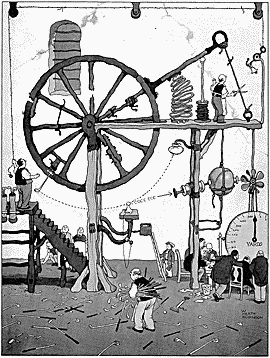 This
is the secret of his humor as well. By the start of WWI, WHR was
famous for his series of drawings poking fun at various facets
of modern living. From industry to sport to the simply absurd,
Robinson carried normal tasks to ridiculous but sober extremes,
and that serious detachment from the subject provided a depth
and gravity to the humor that transcended silliness. A typical
Heath Robinson involved a panoramic view of a complex and convoluted
contraption. The device, usually dilapidated from intense use,
is designed to perform a very simple task and is usually run by
a large group of overly serious attendants - each executing a
simple task like ringing a bell or cutting a string. The mechanism
[which was popularized in the states by Rube Goldberg's homages
- what we in the U.S. call a 'Rube Goldberg device' is simply
a 'Heath Robinson' in the U.K.], derives its humor as much from
the cleverness and complexity of the contraption as from the implied
effort that these serious souls are going to expend to reset it
for the next run. And Robinson's vantage point usually maintained
a quite proper distance from the activities.
This
is the secret of his humor as well. By the start of WWI, WHR was
famous for his series of drawings poking fun at various facets
of modern living. From industry to sport to the simply absurd,
Robinson carried normal tasks to ridiculous but sober extremes,
and that serious detachment from the subject provided a depth
and gravity to the humor that transcended silliness. A typical
Heath Robinson involved a panoramic view of a complex and convoluted
contraption. The device, usually dilapidated from intense use,
is designed to perform a very simple task and is usually run by
a large group of overly serious attendants - each executing a
simple task like ringing a bell or cutting a string. The mechanism
[which was popularized in the states by Rube Goldberg's homages
- what we in the U.S. call a 'Rube Goldberg device' is simply
a 'Heath Robinson' in the U.K.], derives its humor as much from
the cleverness and complexity of the contraption as from the implied
effort that these serious souls are going to expend to reset it
for the next run. And Robinson's vantage point usually maintained
a quite proper distance from the activities.
 He
applied his special touch to topics like Golfers (an easy and
frequent target), the War, Flat Life (post war housing space was
at a premium), Gardening, Motoring, Husbands, Flying (see right),
and many others. Collections appeared in book form over the next
30 years. Hunlikely! (1916), The Homemade Car (1921),
Humours of Golf (1923), Absurdities (1934), Railway
Ribaldry (1935), How to Live in a Flat (1936), How
to be a Perfect Husband (1937), How to Make a Garden Grow
(1938), How to be a Motorist (1939), etc. Many of these
had over 100 illustrations and all display a detached sympathy
for the foibles of the subjects. Some were reprinted in the 1970s-80's
by Duckworth, who also compiled collections under titles like
The Best of Heath Robinson, Heath Robinson at War,
and Inventions.
He
applied his special touch to topics like Golfers (an easy and
frequent target), the War, Flat Life (post war housing space was
at a premium), Gardening, Motoring, Husbands, Flying (see right),
and many others. Collections appeared in book form over the next
30 years. Hunlikely! (1916), The Homemade Car (1921),
Humours of Golf (1923), Absurdities (1934), Railway
Ribaldry (1935), How to Live in a Flat (1936), How
to be a Perfect Husband (1937), How to Make a Garden Grow
(1938), How to be a Motorist (1939), etc. Many of these
had over 100 illustrations and all display a detached sympathy
for the foibles of the subjects. Some were reprinted in the 1970s-80's
by Duckworth, who also compiled collections under titles like
The Best of Heath Robinson, Heath Robinson at War,
and Inventions.
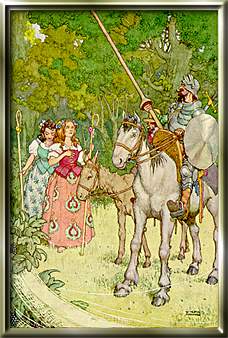 His
autobiography, My Line of Life, was published in 1938.
When he died in 1944, he left behind an unfinished sequel to Uncle
Lubin and illustrations for yet another version of Don
Quixote. This was published in 1953 with the majority of the
b&w illustrations in it taken from his 1902 edition. Color
plate adult books were less popular in the 1950s, and it's a tribute
to his status and reputation that this was published at all. The
color illustrations (as at left) were sound and appropriate yet
somehow uninspired.
His
autobiography, My Line of Life, was published in 1938.
When he died in 1944, he left behind an unfinished sequel to Uncle
Lubin and illustrations for yet another version of Don
Quixote. This was published in 1953 with the majority of the
b&w illustrations in it taken from his 1902 edition. Color
plate adult books were less popular in the 1950s, and it's a tribute
to his status and reputation that this was published at all. The
color illustrations (as at left) were sound and appropriate yet
somehow uninspired.
In 1991, a collection of 350 drawings that WHR created between 1920 and 1922 were discovered. They had been commissioned by publisher Jonathan Cape for a proposed edition of the complete works of Shakespeare. It was never realized, but I would hope that someday someone will see fit to share this treasure trove with the rest of us.
Special thanks due to Geoffrey Beare and James Hamilton for their splendid biographical efforts.
 To learn more about William Heath Robinson, see:
To learn more about William Heath Robinson, see:| My Life of Line | William Heath Robinson, 1938 Blackie & Sons |
| Heath Robinson Artist and Comic Genius | John Lewis, 1973 Barnes and Noble |
| The Fantastic Paintings of Charles and William Heath Robinson | Leo John De Freitas, 1976 Peacock/Bantam |
| W. Heath Robinson | Geoffrey Beare, 1987 Chris Beetles |
| William Heath Robinson | James Hamilton, 1992 Pavilion |
| The Brothers Robinson | Geoffrey Beare, 1992 Chris Beetles |
| The Vadeboncoeur Collection of Knowledge | Jim Vadeboncoeur, Jr. 2000 |
| The Vadeboncoeur Collection of ImageS B&W 2 | Jim Vadeboncoeur, Jr. 2004 JVJ Publishing |
|
Illustrations are copyright
by their respective owners. This page written, designed & © 2000 by Jim Vadeboncoeur, Jr. Updated 2011. |
